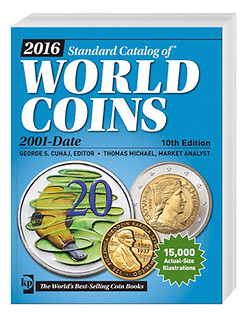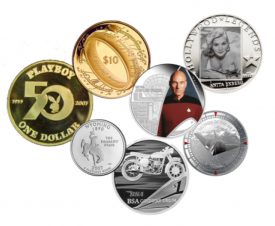
PREV ARTICLE
NEXT ARTICLE
FULL ISSUE
PREV FULL ISSUE
THE PROBLEM OF POSTMODERN "COIN" ISSUES
A September 13, 2016 CoinWeek article by Charles Morgan examines the plethora of commemorative "coins" in the
marketplace today and the implications for the future of the numismatic hobby. Here's a VERY short excerpt; be sure to read the
complete article online. -Editor
At 1,344 pages, The Standard Catalog of World Coins: 2001-Date is an impressive volume. But the prodigious output of new coin designs from each of the world’s mints has not only rendered this book obsolete, but rendered the concept of a single-volume encyclopedia devoted to 21st-century world coins untenable. Consider this. Since its debut in 2007, The Standard Catalog of World Coins: 2001-Date has increased in size by an average of 118 pages per year. Should the annual output of new coins from the world’s mints continue at this pace, the 94th edition of The Standard Catalog (which, one assumes, would be scheduled for publication in the year 2100) would exceed 11,000 pages. This assumes that coins will continue to be produced and that the medium doesn’t find itself replaced by digital or altogether different forms of payment. Which means that, by the end of this century, the number of new coin designs issued by the world mints will dwarf the entirety of all known coinage struck from the middle ages to the year 2000. But that’s nothing compared to the actual number of pieces struck. The United States Mint alone has already struck more than 180 billion coins. That number could exceed one trillion circulating coins by the end of the century. Add to that all of the circulating coins that will be struck by every nation across the globe. The number of coins that will be produced this century (ceteris paribus) will be simply staggering. And believe it or not, despite the fact that almost none of the coin issues will be what one would naturally consider rare, there will still be a built-in collector base for them. Coin collectors of all ages and experience levels have traditionally enjoyed collecting their country’s circulating coinage. For many, discovering and accumulating the older coins that circulate alongside newer ones is the first act of a budding collector. After doing this a while, it becomes apparent to these collectors that there are gaps in their collection, coins they can’t find. Perhaps they will buy an informative book or magazine, or read about their preferred series online. And in order to acquire these missing coins–the coins they couldn’t find in their change–collectors have trade for them or buy them from other collectors or coin dealers. It is at this point that new coin collectors enter the numismatic marketplace.
And as these corporate mints have become innovators and leaders in the marketplace, the more traditionally-structured mints have followed suit. The result of this industry transformation has been a dramatic redefinition of what a coin is as a physical object; as a social construct; and what role the coin-producing mints play in the numismatic marketplace.
The article covers the history of commemorative coins and medals from the Great Depression through The Franklin Mint and up to
today's "postmodern coins", with both private and public mints churning out product after product. -Editor
And while it’s safe to say that a viable market in bullion coins – that is, precious metals coins sold at or near the current market price for their constituent metal – is thriving and supported by a sophisticated network of retailers, wholesalers and consumers, the same cannot be said about precious metals coins that are issued for premiums well above the coin’s intrinsic value. This is a problem. For coins, unlike cars, computers, or other consumables, do not get used up and discarded. Instead, they are purchased with the belief that they are a store of value and the expectation that this value will increase over time. Without a proportionally-sized and well-developed secondary market, these goals cannot be realized.
Will a secondary market for these emissions evolve over time? The answer is almost certainly yes, but that begs the author's point,
which is that market levels will likely be far below the prices charged and paid today. People are going to lose a lot of money, just
like the initial buyers of many Franklin Mint products. -Editor
To read the complete article, see:
THE BOOK BAZARREWayne Homren, Editor The Numismatic Bibliomania Society is a non-profit organization promoting numismatic literature. See our web site at coinbooks.org. To submit items for publication in The E-Sylum, write to the Editor at this address: whomren@gmail.com To subscribe go to: https://my.binhost.com/lists/listinfo/esylum All Rights Reserved. NBS Home Page Contact the NBS webmaster 
|

